#Nagasaki World War II
Text
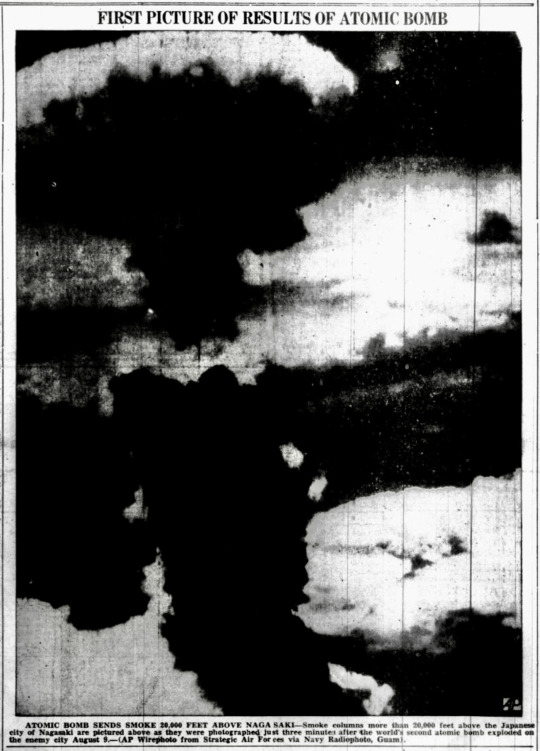
"First picture of results of atomic bomb." From the front page for the Gainesville Daily Register, Texas, August 13, 1945.
#hiroshima#nagasaki#history#japan#atom bomb#atomic#nuclear#military history#war#wwii#ww2#world war ii#second world war#world war 2
321 notes
·
View notes
Text
Idk if this is a hot take or not but I feel the need to stress: no discussion about the bombings of hiroshima and nagasaki has any reason to mention Japanese war crimes. Literally nothing a government does justifies killing random people who happen to live in that government's territory. It is genocidal rhetoric to act as if a group of people can do something that justifes killing massive amounts of them.
There is an idea in western culture that we can judge warcrimes based on how "good" of a group were the victims. This dates back to the conquest of the Aztec empire, where things that horrified Europeans at the time where justified by bringing up terrible things done by the Aztec government. People defend the Spanish empire on those grounds today. It's so pervasive that it'll even come up when people are talking agaisnt genocides (they'll bring up native groups being peaceful as the reason why westward expansion was bad, as if them being human wasn't enough).
Would Russia be justified in nuking the US because the US government committed warcrimes in the middle east? (Actually speaking of Russia, you'll see this rhetoric when tankies bring up Ukraine's nazi problem.) Because if not, and you think hiroshima and nagasaki were justified, then you have to give a reason other then the fact that you judge the lives of westerners and nonwesterners differently.
If someone brings up crimes a group committed, real or imaginary, when arguing about atrocities committed agaisnt them, they've already told you that they don't believe people of that group have rights, that they believe anything can be done to them if it's justified.
There is no crime someone can commit, that's so bad that it justifies killing a stranger who happens to speak the same language as them.
#hiroshima#hiroshima and nagasaki#nagasaki#nuclear#nuclear weapons#nuclear war#racisim#anti genocide#genocide#world war 2#world war ii#history#discourse#war crimes#war criminals#imperialism#anti imperialism#oppenheimer#anti war
215 notes
·
View notes
Text



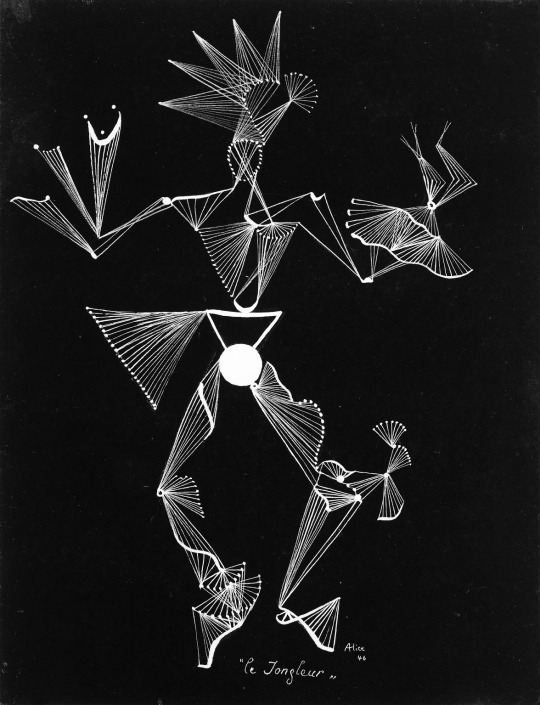

Ballet de Orión, Alice Rahon, 1946
The invisible speaks to us, and the world it paints takes the form of apparitions; it awakens in each of us that yearning for the marvelous... A.R.
Animation by Schirn Kunsthalle
#art#alice rahon#drawing#1940s#surrealism#orion#astrology#constellations#mayan culture#world war ii#hiroshima#nagasaki#painting#shape-shifter#french artists#mexican artists#quotes#gif#animation
29 notes
·
View notes
Text

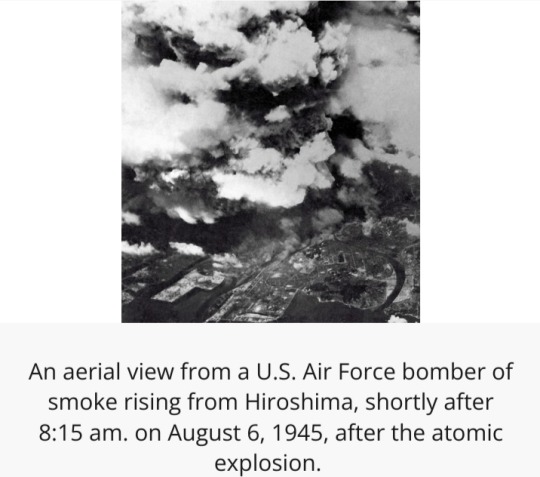
On 6 August 1945, during World War II (1939-45), an American B-29 bomber dropped the world’s first deployed atomic bomb over the Japanese city of Hiroshima.
The explosion immediately killed an estimated 80,000 people; tens of thousands more would later die of radiation exposure.
Three days later, a second B-29 dropped another A-bomb on Nagasaki, killing an estimated 40,000 people.
Japan’s Emperor Hirohito announced his country’s unconditional surrender in World War II in a radio address on August 15, citing the devastating power of “a new and most cruel bomb.”
The Manhattan Project
Even before the outbreak of war in 1939, a group of American scientists — many of them refugees from fascist regimes in Europe — became concerned with nuclear weapons research being conducted in Nazi Germany.
In 1940, the U.S. government began funding its own atomic weapons development program, which came under the joint responsibility of the Office of Scientific Research and Development and the War Department after the U.S. entry into World War II.
The U.S. Army Corps of Engineers was tasked with spearheading the construction of the vast facilities necessary for the top-secret program, codenamed “The Manhattan Project” (for the engineering corps’ Manhattan district).

Over the next several years, the program’s scientists worked on producing the key materials for nuclear fission — uranium-235 and plutonium (Pu-239).
They sent them to Los Alamos, New Mexico, where a team led by J. Robert Oppenheimer worked to turn these materials into a workable atomic bomb.
Early on the morning of 16 July 1945, the Manhattan Project held its first successful test of an atomic device — a plutonium bomb — at the Trinity test site at Alamogordo, New Mexico.
No Surrender for the Japanese
By the time of the Trinity test, the Allied powers had already defeated Germany in Europe.
Japan, however, vowed to fight to the bitter end in the Pacific, despite clear indications (as early as 1944) that they had little chance of winning.
In fact, between mid-April 1945 (when President Harry Truman took office) and mid-July, Japanese forces inflicted Allied casualties totaling nearly half those suffered in three full years of war in the Pacific, proving that Japan had become even more deadly when faced with defeat.
In late July, Japan’s militarist government rejected the Allied demand for surrender put forth in the Potsdam Declaration, which threatened the Japanese with “prompt and utter destruction” if they refused.
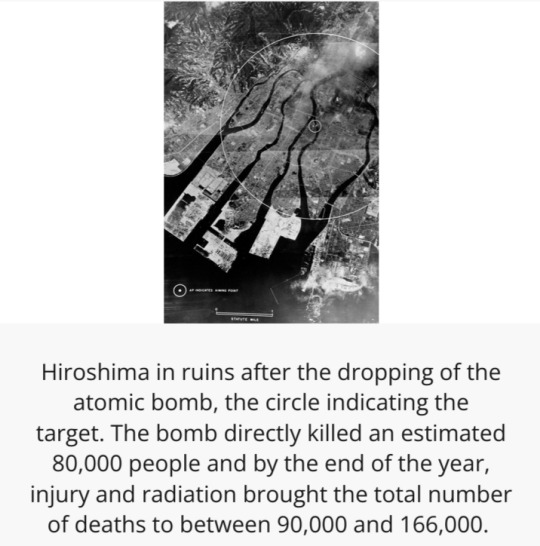
General Douglas MacArthur and other top military commanders favored continuing the conventional bombing of Japan already in effect and following up with a massive invasion, codenamed “Operation Downfall.”
They advised Truman that such an invasion would result in U.S. casualties of up to 1 million.
In order to avoid such a high casualty rate, Truman decided – over the moral reservations of Secretary of War Henry Stimson, General Dwight Eisenhower and a number of the Manhattan Project scientists – to use the atomic bomb in the hopes of bringing the war to a quick end.
Proponents of the A-bomb — such as James Byrnes, Truman’s secretary of state — believed that its devastating power would not only end the war but also put the U.S. in a dominant position to determine the course of the postwar world.
'Little Boy' and 'Fat Man' Are Dropped
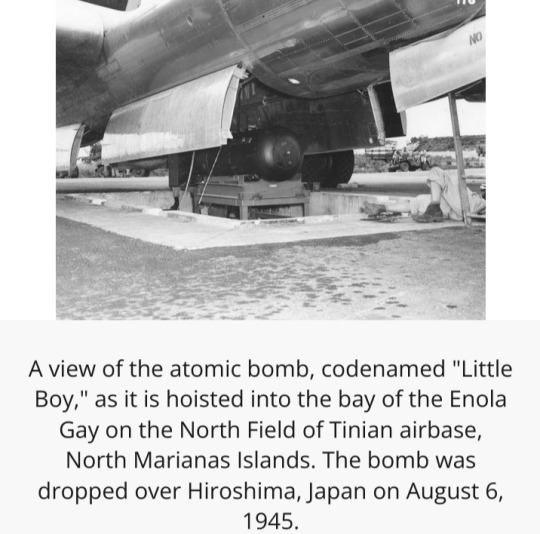
Hiroshima, a manufacturing center of some 350,000 people located about 500 miles from Tokyo, was selected as the first target.
After arriving at the U.S. base on the Pacific island of Tinian, the more than 9,000-pound uranium-235 bomb was loaded aboard a modified B-29 bomber christened Enola Gay (after the mother of its pilot, Colonel Paul Tibbets).
The plane dropped the bomb — known as “Little Boy” — by parachute at 8:15 in the morning.
It exploded 2,000 feet above Hiroshima in a blast equal to 12-15,000 tons of TNT, destroying five square miles of the city.
Hiroshima’s devastation failed to elicit immediate Japanese surrender, however, and on August 9, Major Charles Sweeney flew another B-29 bomber, Bockscar, from Tinian.
Thick clouds over the primary target, the city of Kokura, drove Sweeney to a secondary target, Nagasaki, where the plutonium bomb “Fat Man” was dropped at 11:02 that morning.
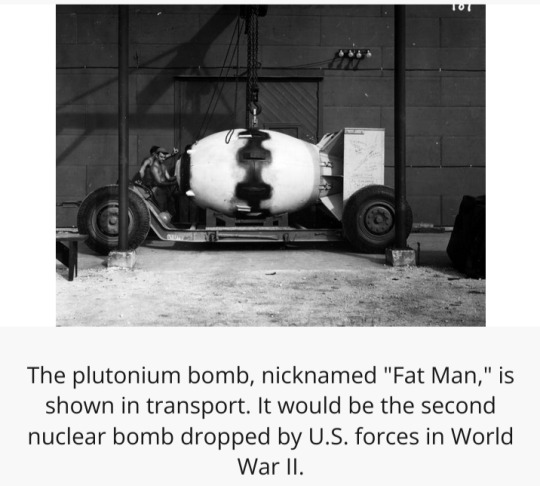
More powerful than the one used at Hiroshima, the bomb weighed nearly 10,000 pounds and was built to produce a 22-kiloton blast.
The topography of Nagasaki, which was nestled in narrow valleys between mountains, reduced the bomb’s effect, limiting the destruction to 2.6 square miles.
Aftermath of the Bombing

At noon on 15 August 1945 (Japanese time), Emperor Hirohito announced his country’s surrender in a radio broadcast.
The news spread quickly.
“Victory in Japan” or “V-J Day” celebrations broke out across the United States and other Allied nations.
The formal surrender agreement was signed on September 2, aboard the U.S. battleship Missouri, anchored in Tokyo Bay.
Because of the extent of the devastation and chaos — including the fact that much of the two cities' infrastructure was wiped out — exact death tolls from the bombing of Hiroshima and Nagasaki remain unknown.
However, it's estimated roughly 70,000 to 135,000 people died in Hiroshima and 60,000 to 80,000 people died in Nagasaki, both from acute exposure to the blasts and from long-term side effects of radiation.


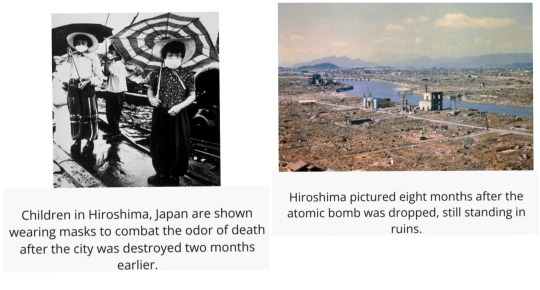
#Bombing of Hiroshima and Nagasaki (1945)#6 August 1945#atomic bomb#Hiroshima#Nagasaki#B-29 bomber#A-bomb#U.S. Army Corps of Engineers#The Manhattan Project#nuclear weapons research#Office of Scientific Research and Development#War Department#World War II#WWII#uranium-235#plutonium (Pu-239)#nuclear fission#plutonium bomb#J. Robert Oppenheimer#Oppenheimer#Trinity test#Potsdam Declaration#General Douglas MacArthur#Operation Downfall#Henry Stimson#General Dwight Eisenhower#Enola Gay#Colonel Paul Tibbets#Bockscar#V-J Day
32 notes
·
View notes
Text
In war there are no winners, only widows.
— Arrival (2016), directed by Denis Villeneuve and adapted by Eric Heisserer. This sentence is said in Mandarin, and no translation is provided on screen.
#arrival#ted chiang#story of your life#oppenheimer#nuclear war#world war 2#world war ii#center for nuclear disarmament#hiroshima and nagasaki
48 notes
·
View notes
Text
The First Light of Trinity
— By Alex Wellerstein | July 16, 2015 | Annals of Technology

Seventy years ago, the flash of a nuclear bomb illuminated the skies over Alamogordo, New Mexico. Courtesy Los Alamos National Laboratory
The light of a nuclear explosion is unlike anything else on Earth. This is because the heat of a nuclear explosion is unlike anything else on Earth. Seventy years ago today, when the first atomic weapon was tested, they called its light cosmic. Where else, except in the interiors of stars, do the temperatures reach into the tens of millions of degrees? It is that blistering radiation, released in a reaction that takes about a millionth of a second to complete, that makes the light so unearthly, that gives it the strength to burn through photographic paper and wound human eyes. The heat is such that the air around it becomes luminous and incandescent and then opaque; for a moment, the brightness hides itself. Then the air expands outward, shedding its energy at the speed of sound—the blast wave that destroys houses, hospitals, schools, cities.
The test was given the evocative code name of Trinity, although no one seems to know precisely why. One theory is that J. Robert Oppenheimer, the head of the U.S. government’s laboratory in Los Alamos, New Mexico, and the director of science for the Manhattan Project, which designed and built the bomb, chose the name as an allusion to the poetry of John Donne. Oppenheimer’s former mistress, Jean Tatlock, a student at the University of California, Berkeley, when he was a professor there, had introduced him to Donne’s work before she committed suicide, in early 1944. But Oppenheimer later claimed not to recall where the name came from.
The operation was designated as top secret, which was a problem, since the whole point was to create an explosion that could be heard for a hundred miles around and seen for two hundred. How to keep such a spectacle under wraps? Oppenheimer and his colleagues considered several sites, including a patch of desert around two hundred miles east of Los Angeles, an island eighty miles southwest of Santa Monica, and a series of sand bars ten miles off the Texas coast. Eventually, they chose a place much closer to home, near Alamogordo, New Mexico, on an Army Air Forces bombing range in a valley called the Jornada del Muerto (“Journey of the Dead Man,” an indication of its unforgiving landscape). Freshwater had to be driven in, seven hundred gallons at a time, from a town forty miles away. To wire the site for a telephone connection required laying four miles of cable. The most expensive single line item in the budget was for the construction of bomb-proof shelters, which would protect some of the more than two hundred and fifty observers of the test.
The area immediately around the bombing range was sparsely populated but not by any means barren. It was within two hundred miles of Albuquerque, Santa Fe, and El Paso. The nearest town of more than fifty people was fewer than thirty miles away, and the nearest occupied ranch was only twelve miles away—long distances for a person, but not for light or a radioactive cloud. (One of Trinity’s more unusual financial appropriations, later on, was for the acquisition of several dozen head of cattle that had had their hair discolored by the explosion.) The Army made preparations to impose martial law after the test if necessary, keeping a military force of a hundred and sixty men on hand to manage any evacuations. Photographic film, sensitive to radioactivity, was stowed in nearby towns, to provide “medical legal” evidence of contamination in the future. Seismographs in Tucson, Denver, and Chihuahua, Mexico, would reveal how far away the explosion could be detected.

The Trinity test weapon. Courtesy Los Alamos National Laboratory
On July 16, 1945, the planned date of the test, the weather was poor. Thunderstorms were moving through the area, raising the twin hazards of electricity and rain. The test weapon, known euphemistically as the gadget, was mounted inside a shack atop a hundred-foot steel tower. It was a Frankenstein’s monster of wires, screws, switches, high explosives, radioactive materials, and diagnostic devices, and was crude enough that it could be tripped by a passing storm. (This had already happened once, with a model of the bomb’s electrical system.) Rain, or even too many clouds, could cause other problems—a spontaneous radioactive thunderstorm after detonation, unpredictable magnifications of the blast wave off a layer of warm air. It was later calculated that, even without the possibility of mechanical or electrical failure, there was still more than a one-in-ten chance of the gadget failing to perform optimally.
The scientists were prepared to cancel the test and wait for better weather when, at five in the morning, conditions began to improve. At five-ten, they announced that the test was going forward. At five-twenty-five, a rocket near the tower was shot into the sky—the five-minute warning. Another went up at five-twenty-nine. Forty-five seconds before zero hour, a switch was thrown in the control bunker, starting an automated timer. Just before five-thirty, an electrical pulse ran the five and a half miles across the desert from the bunker to the tower, up into the firing unit of the bomb. Within a hundred millionths of a second, a series of thirty-two charges went off around the device’s core, compressing the sphere of plutonium inside from about the size of an orange to that of a lime. Then the gadget exploded.
General Thomas Farrell, the deputy commander of the Manhattan Project, was in the control bunker with Oppenheimer when the blast went off. “The whole country was lighted by a searing light with the intensity many times that of the midday sun,” he wrote immediately afterward. “It was golden, purple, violet, gray, and blue. It lighted every peak, crevasse, and ridge of the nearby mountain range with a clarity and beauty that cannot be described but must be seen to be imagined. It was that beauty the great poets dream about but describe most poorly and inadequately.” Twenty-seven miles away from the tower, the Berkeley physicist and Nobel Prize winner Ernest O. Lawrence was stepping out of a car. “Just as I put my foot on the ground I was enveloped with a warm brilliant yellow white light—from darkness to brilliant sunshine in an instant,” he wrote. James Conant, the president of Harvard University, was watching from the V.I.P. viewing spot, ten miles from the tower. “The enormity of the light and its length quite stunned me,” he wrote. “The whole sky suddenly full of white light like the end of the world.”
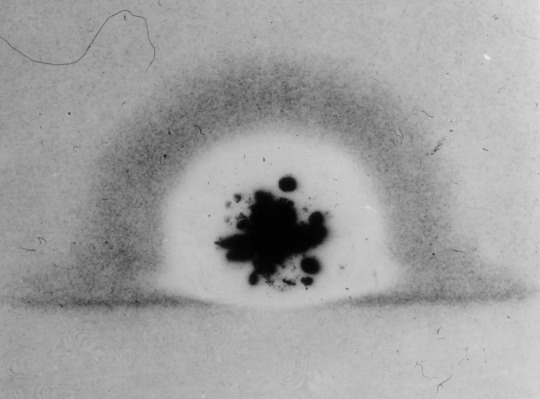
In its first milliseconds, the Trinity fireball burned through photographic film. Courtesy National Archives and Records Administration
Trinity was filmed exclusively in black and white and without audio. In the main footage of the explosion, the fireball rises out of the frame before the cameraman, dazed by the sight, pans upward to follow it. The written accounts of the test, of which there are many, grapple with how to describe an experience for which no terminology had yet been invented. Some eventually settle on what would become the standard lexicon. Luis Alvarez, a physicist and future participant in the Hiroshima bombing, viewed Trinity from the air. He likened the debris cloud, which rose to a height of some thirty thousand feet in ten minutes, to “a parachute which was being blown up by a large electric fan,” noting that it “had very much the appearance of a large mushroom.” Charles Thomas, the vice-president of Monsanto, a major Manhattan Project contractor, observed the same. “It looked like a giant mushroom; the stalk was the thousands of tons of sand being sucked up by the explosion; the top of the mushroom was a flowering ball of fire,” he wrote. “It resembled a giant brain the convolutions of which were constantly changing.”
In the months before the test, the Manhattan Project scientists had estimated that their bomb would yield the equivalent of between seven hundred and five thousand tons of TNT. As it turned out, the detonation force was equal to about twenty thousand tons of TNT—four times larger than the expected maximum. The light was visible as far away as Amarillo, Texas, more than two hundred and eighty miles to the east, on the other side of a mountain range. Windows were reported broken in Silver City, New Mexico, some hundred and eighty miles to the southwest. Here, again, the written accounts converge. Thomas: “It is safe to say that nothing as terrible has been made by man before.” Lawrence: “There was restrained applause, but more a hushed murmuring bordering on reverence.” Farrell: “The strong, sustained, awesome roar … warned of doomsday and made us feel that we puny things were blasphemous.” Nevertheless, the plainclothes military police who were stationed in nearby towns reported that those who saw the light seemed to accept the government’s explanation, which was that an ammunition dump had exploded.
Trinity was only the first nuclear detonation of the summer of 1945. Two more followed, in early August, over Hiroshima and Nagasaki, killing as many as a quarter of a million people. By October, Norris Bradbury, the new director of Los Alamos, had proposed that the United States conduct “subsequent Trinity’s.” There was more to learn about the bomb, he argued, in a memo to the new coördinating council for the lab, and without the immediate pressure of making a weapon for war, “another TR might even be FUN.” A year after the test at Alamogordo, new ones began, at Bikini Atoll, in the Marshall Islands. They were not given literary names. Able, Baker, and Charlie were slated for 1946; X-ray, Yoke, and Zebra were slated for 1948. These were letters in the military radio alphabet—a clarification of who was really the master of the bomb.
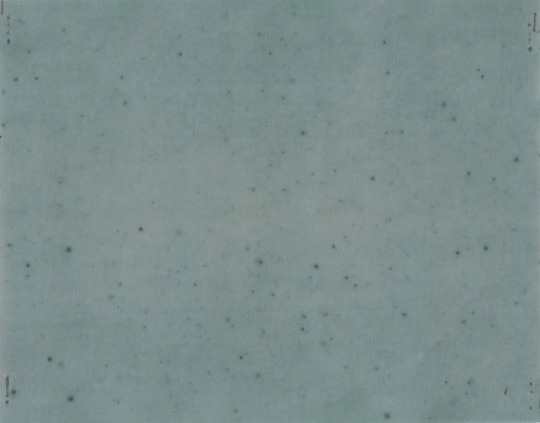
Irradiated Kodak X-ray film. Courtesy National Archives and Records Administration
By 1992, the U.S. government had conducted more than a thousand nuclear tests, and other nations—China, France, the United Kingdom, and the Soviet Union—had joined in the frenzy. The last aboveground detonation took place over Lop Nur, a dried-up salt lake in northwestern China, in 1980. We are some years away, in other words, from the day when no living person will have seen that unearthly light firsthand. But Trinity left secondhand signs behind. Because the gadget exploded so close to the ground, the fireball sucked up dirt and debris. Some of it melted and settled back down, cooling into a radioactive green glass that was dubbed Trinitite, and some of it floated away. A minute quantity of the dust ended up in a river about a thousand miles east of Alamogordo, where, in early August, 1945, it was taken up into a paper mill that manufactured strawboard for Eastman Kodak. The strawboard was used to pack some of the company’s industrial X-ray film, which, when it was developed, was mottled with dark blotches and pinpoint stars—the final exposure of the first light of the nuclear age.
#Hiroshima | Japan 🇯🇵 | John Donne | Manhattan Project | Monsanto#Nagasaki | Japan 🇯🇵 | Nuclear Weapons | Second World War | World War II#The New Yorker#Alex Wellerstein#Los Alamos National Laboratory#New Mexico#J. Robert Oppenheimer#John Donne#Jean Tatlock#University of California Berkeley#Jornada del Muerto | Journey of the Dead Man#General Thomas Farrell#Nobel Prize Winner Physicist Ernest O. Lawrence#Luis Alvarez#US 🇺🇸#China 🇨🇳#France 🇫🇷#Soviet Union (Now Russia 🇷🇺)#Alamogordo | New Mexico#Eastman Kodak#Nuclear Age
38 notes
·
View notes
Text
Howdy folks, I’m currently working on a video on Godzilla and wanted to understand as much of the historical context surrounding the original film (and as much as I can get for each of the subsequent films). So i wanted to jump on here and ask if anyone has good history books that talk about japan before, during and after the war. Also if you have any good japanese history books in general (obviously preferably in english as i don’t speak japanese and would rather defenstrate myself then google translate a history book). Any and all help will be greatly appreciated.
#japan#japanese#world war 2#world war ii#imperialism#imperial japanese army#nukes#hiroshima#nagasaki#big boy#nuclear#cold war#america#oppenheimer#Godzilla#gojira#godzilla 1954#godzilla 1998#godzilla vs kong#godzilla vs megalon#godzilla vs mechagodzilla#godzilla vs destoroyah#godzilla vs king kong#godzilla vs hedorah#godzilla vs king ghidorah#godzilla vs gigan#godzilla vs biollante#godzilla vs mothra#godzila#gal.txt
6 notes
·
View notes
Text
Blood on his hands
The worst hell ever unleashed on the planet occurred on August 6th and 9th in 1945.
Atomic bombs were dropped on Hiroshima and Nagasaki, annihilating more than 200,000 people, most of them civilians, and hideously disfiguring tens of thousands more.
The twin holocausts ended World War II — Japan surrendered to the Allies on August 15 — but the world would forever walk a tightrope of total…
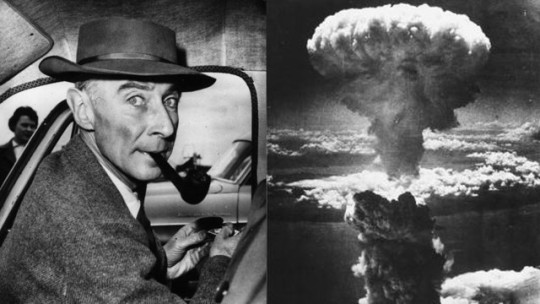
View On WordPress
4 notes
·
View notes
Text
Some guy once thought my Māori middle name Ngakaari (Nah-Car-Ree) was Nagasaki once. I didn't know whether to slap him or laugh to be honest. I'm mostly European with some Māori ethnicity if you're wondering. Still dude, do you not remember what happened in WWII in Nagasaki and Hiroshima?! The guy was American, not that I'm hating on all Americans but....wow, just wow.
#being a new zealander#new zealand#māori#european#ethnicity#aotearoa#land of the long white cloud#tumblr thoughts#nagasaki#hiroshima#japan#world war ii#ffs some people#some people speak before they think#some people comment before they speak
0 notes
Text
The Horror.
youtube

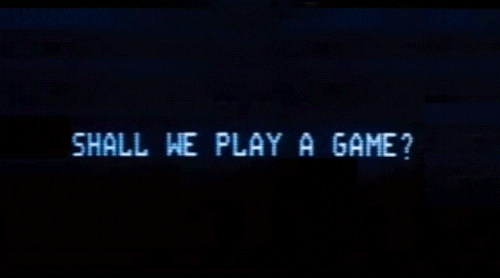
🎼🎹 “...It’s a very, very M.A.D. World...“
#barbenheimer#oppenheimer#Horror Movies#real horror show#sublime#war#world war II#anime#manga#nihilist#nihilism#horror#true horror#world war#physics#nuclear war#Hiroshima#Nagasaki
0 notes
Text
1945 Wolverine Vol III
Logan looks 23/24.
Inspired by this scene from The Wolverine movie.
World War II is nearing it's end. The Marine unit of Victor Creed and Logan has been sent to the invasion of Okinawa. The mood amongst the men in the transport is low, but they are trying to banter and make light.
Logan is surly, not wanting to join in. He is a soldier because he is good at it, not because he enjoys it. He is there to do a job.
Victor is the complete opposite. He seems to be having the time of his life. He laughs raucously at the jokes and chastises Logan for his attitude. He says this is a once in a lifetime opportunity (for some of you) to win a war, beat the enemy…to death. The others, save Logan, cheer at this.
Victor sits with Logan…
V: You should be happy, this is a good life. We do a job we're good at, we make our living from it…you should at least try to enjoy it.
L: You enjoy it too much.
V: Why shouldn't I? I've lost count of my enemy kills, but I know it's higher than yours.
L: Don't you ever get tired of killing?
V: What else are you gonna do? Watercolors? Wildlife photography?
L: …
V: We're made for killing. You certainly aren't much good for anything else.
L: …When we were in Spain-
V: Are you still pissed off about that? Logan that was nearly a decade ago.
L: Those men were-
V: We are not men. We're not like them. You end up caring for them and then get upset when they...
L: Victor-
V: Stop trying to protect them.
The other conversations have died down and the brothers realise they are being listened to.
L: You're damn right I care. What about these men we serve with. Are they not our brothers too? Would you kill them Victor?
V (grinning): In a heartbeat.
Silence.
One of the marines asks Victor if he's joking. Victor lets out a hearty laugh and the others, save Logan, join in.
Logan knows he means it.
Then we cut to a fighting, moving, sweeping across the Island, capturing an airbase and Logan and Victor's differing-responses-to-the-violence montage. Logan tries hard not to react with sadness when members of their unit are killed. He responds with anger instead.
Then we see the remaining marines pinned down under heavy fire. Victor and Logan become separated from the rest of the unit and try to make ground themselves rather than get shot where they lie.
They come across a pillbox embrasure. They both take some hits. They storm the pill box, get inside and kill the soldiers. Logan is efficient, Victor slaughters them with glee.
Logan starts to admonish him when the pillbox is destroyed by an American shell.
Cut to black.
Logan comes to, heavily restrained in a basic treatment room. There are scratch marks, lacerations and deep gouges on the walls. Also a certain amount of blood.
A young Japanese guard sits, skittish, by the door. Recovering his wits a little, he strains against his bonds.
The guard jumps up and tries to grab his rifle. Snikt! The claws come out. The guard runs out.
Logan can't break the restraints nor angle the claws to cut them. He accidentally cuts himself in the struggle. The pain snaps him out of his instinctive reverie. He retracts the claws. The wound starts to heal.
There is shouting, in Japanese, outside the room.
The officer in charge of the camp, wearing his arm in a sling, enters. He sees that Logan is relatively calm. He sees Logan's fresh leg wound healing up. He remarks that Logan has some unusual gifts. That he survived a direct hit from an American shell. His body was still healing when they brought him in.
He introduces himself in his best English. His name is Ichirō Yashida. He says that he knows his men sometimes talk behind his back, they say he is too lenient. He says they are all men and should be afforded some respect, even in captivity.
He says that Logan is not a man, he is something else. They have had to treat him differently.
Logan asks if he caused Ichirō's injury. He did. He apologises. He says sometimes he is not in control of what he is doing. Instinct takes over.
He asks if anyone else was brought in with him.
Ichirō says there was another. The same gifts as Logan. When he woke he killed three men, injured more, and escaped. They believe he is long gone as there is no sign of him.
Logan says they are both very good at hiding and covering their tracks. He may still be here.
They have a few conversations, Ichirō is trying to get an understanding of the threat level.
I: What is your role in the military?
L: I have been an engineer, saboteur, sapper, sniper, assassin…you name it, I've been it. I started by following men to their deaths, now I lead them to theirs, only I can't die.
L: Killing…it's what I do best.
I: Is that a threat?
L: No. Just a fact…It's the only life I know.
I: Are you here to kill anyone?
L: No. I was just in the wrong place at the wrong time.
I: Are there more like you, in your unit?
L: I only met one other like me, and you said he's long gone.
Gradually they come to an understanding and Logan is released from his bonds and into the camp.
He starts to get to know the guards and other prisoners. He tries to take on more than his share to save the others from hard labour. The guards don't argue because they are scared of him.
Against his better judgement he begins to like the other POWs. He starts to develop a mutual respect with the guards and staff, especially Ichirō.
Then it starts. Late one night a guard is brutally killed, as if by a beast.
They think Logan did it.
Despite his protestations they lock him up in the recovery room like before.
It happens again, two guards this time.
They put him in solitary, down in a solitary underground cell.
It happens again, a POW spots the culprit and is killed too.
The guard in the tower sees it is not Logan and tells Yashida.
Logan knows exactly what is happening and pleads to be let out to face him. Victor is looking for Logan and won't stop until he finds him.
He comes again so they relent and release him. It obviously is Victor and he wants to take out the whole camp. The Japanese who run the camp and any witnesses. Logan is already angry at Vic for his brutality but he cannot countenance any further killing when they could just escape. Victor won't take no for an answer.
They fight having not done so seriously for decades. And when they did Victor would always win.
The fight is epic, brutal and bloody. Vic has the upper hand but is exhausted and totally focused on Wolverine. Ichirō uses this distraction to put a bullet in Vic's head.
Logan says Vic will recover, they have to put him in solitary.
The guards and the POWs are terrified of them both and put them in separate underground cells (I'm pretty sure they only have one in the film but we're having two for narrative purposes).
Then the atom bomb warning comes. The camp is evacuated as per the film.
Yashida hesitates momentarily but then frees Logan. He isn't sure about freeing Vic.
Logan steps forward and cuts the chains. Vic is angry and wants to kill Yashida and get revenge on Logan.
Logan says you want to fight us or you want to try and outrun that bomb?
Vic growls that he won't forget this.
Logan knows.
Vic leaves.
Logan wants to get back in the underground cell. The other officers want Yashida to join them in committing seppuku.
Logan rushes him to the cell and shields him from the blast. He is horribly damaged by the blast but regenerates in front of Yashida.
They spend some time in the cell together and then come out to survey the damage.
They are both left wondering whether Logan or Victor or mankind are most monstrous.
Mid or post credits: Essex, now Sinister, En Sabah Nur's envoy, ushers in another sacrifice. Aaaaah!
#it's all connected#iac#marvel cinematic universe#mcu#wolverine#logan#victor creed#sabretooth#ichirō yashida#nagasaki#world war ii
1 note
·
View note
Video
youtube
World War II: United States against Japan. The story of the B-29 Superfortress, And The Atomic Bomb. Documentary
1 note
·
View note
Text
Me: how did you know that the war was happening? You were in elementary school at the time.
My grandma, with a completely blank face: because I was bombed.
#i freaking hate giraffes#I swear my grandma runs the Japanese mafia#HARDCORE ASIAN GRANDMA WHOO!#WWII#my grandma just bought me a dart gun???#Hiroshima bombing#Nagasaki bombing#world war two#world war ii#japanese#kawaii aesthetic
1 note
·
View note
Text
Do you like to use the Mushroom Cloud as a fun Barbieheimer meme? If you do, it's fine so long as you know what the cloud caused and what it symbolizes. If you don't know the circumstances of the mushroom cloud, please search ''Hiroshima Nagasaki atomic bomb people (with your safe search off)' on Google Images. *The images are very disturbing. Please DO NOT try it if you are sensitive to extremely disturbing images.
I'm Japanese. In Japan, unfortunately, many people have never seen the old pictures of the real effects of the mushroom cloud. We learn about the atomic bombing of Hiroshima and Nagasaki (both are cities in Japan) in primary school or junior high, when we are about 10-14 years old. Many adults think it's too risky to show children the pictures because it shows human bodies, which look like human charcoal. Living people got severe burns on their faces, their backs, and their whole bodies looked like melting wax (additionally, most of the people in the pictures are citizens, not soldiers. There are many kids, babies, and old people, of course.) Even though it happened in our land, many people (including me, I'm ashamed to say though) don't feel it was an actual event because it seems very unreal and it happened almost 80 years ago. Fortunately, I had a chance to learn about the atomic bombing and see several pictures of it. Now I know what happened in 1945. I think some people here/outside of Japan realize it as well.
I don't blame people born outside of Japan who have never known/learned about the effects of the atomic bombing. I want to ask you to learn and understand what happened under that iconic mushroom cloud before you make a meme with it. If you think 'So what?' after that, I will have nothing more to say to you.
I've not seen Barbie or Oppenheimer because they are not released here yet. But I feel they are both very interesting. I'm looking forward to watching them. I wish I could have fun watching them without any distractions before going to the theatres.
Don't get me wrong. I know that during World War II the Japanese government did tons of terrible things to people outside and inside of Japan. I just want people to know that atomic bombing is a very serious issue, and using the images of the mushroom cloud as a meme/design is like using a symbol of the Nazi/KKK as a fun meme. It's not fun. Atomic bombing should never happen anywhere in the world.
#I'm NOT saying it to make Japanese people 'victims' of the memes#I'm afraid that people get used to making jokes about it#or forget how horrible nuclear weapons are#the atomic bomb in 1945 killed 129000-226000 people in total#at least 88% of those were civilians#the total number is uncertain#because in many cases there were no remains to be found
2K notes
·
View notes
Text
Now I am become death, destroyer of worlds.
— J. Robert Oppenheimer, "father of the atomic bomb." Oppenheimer recalled this line from the Hindu scripture Bhagavad Gita, after witnessing the first nuclear weapon test, known as Trinity.
Now we are all sons of bitches.
— Kenneth Bainbridge, director of the Trinity nuclear weapon test.
#oppenheimer#nuclear weapons#history of nuclear weapons#atomic age#quotes#christopher nolan#cillian murphy#hiroshima and nagasaki#center for nuclear disarmament#20th century history#world war II#world war 2
9 notes
·
View notes
Text
Atomic Secrets: The Scientists Who Built The Atom Bomb 💣
Science and the military converged under a cloak of secrecy at Los Alamos National Laboratory. As part of the Manhattan Project, Los Alamos — both its very existence and the work that went on there — was hidden from Americans during World War II.
Many of the thousands of scientists on the project were not officially aware of what they were working on. Though they were not permitted to talk to anyone about their work, including each other, by 1945 some had figured out that they were in fact building an atomic bomb.

In 1943 J. Robert Oppenheimer was named the director of the Bomb Project at Los Alamos, a self-contained area protected -- and completely controlled -- by the U.S. Army. Special driver's licenses had no names on them, just ID numbers. Credit: Courtesy of the Los Alamos National Laboratory Archives

Robert Oppenheimer's wife Kitty was not above scrutiny. All who were affiliated with the project -- and their spouses -- were thoroughly screened and had a security file with the FBI. Credit: Courtesy of the F.B.I.
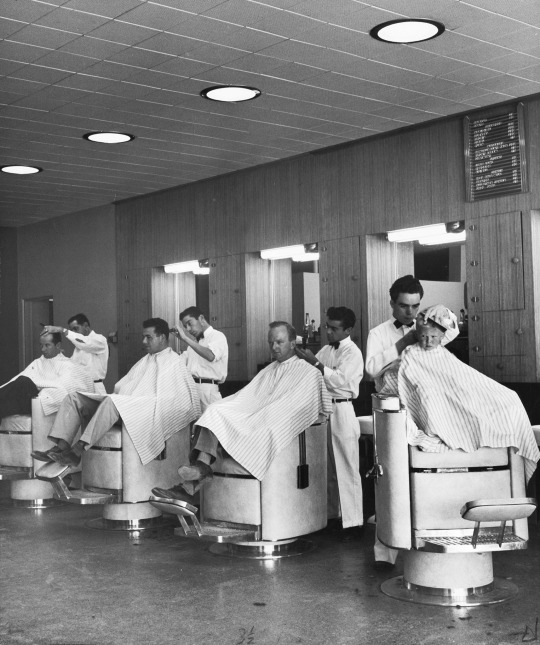
Less than a year after Oppenheimer proposed using the remote desert site for the laboratory, Los Alamos was already home to a thousand scientists, engineers, support staff… and their families. By the end of the war the population was over 6,000, and the compound included amenities like this barber shop. Credit: Time Life/Getty Images

Atomic Bomb Project employees having lunch at Los Alamos. Though food was often in scant supply, residents made the best of life in their isolated community by putting on plays and organizing Saturday night square dances. Some singles’ parties in the dormitories reportedly served a brew of lab alcohol and grapefruit juice, cooled with dry ice out of a 32-gallon GI can. Credit: Copyright Bettmann/CORBIS

Completely self-contained, the Los Alamos facility did not officially exist in its early years except as a post office box. Scientists’ families were mostly kept in the dark about the nature of the project, learning the truth only after the bomb was dropped on Hiroshima. Credit: Courtesy of the Los Alamos National Laboratory Archives

Credited with inventing the cyclotron, University of California-Berkeley physicist Ernest Lawrence (squatting, center) looks on as Robert Oppenheimer points out something on the 184” particle accelerator. Harvard University supplied the cyclotron that was used to develop the atomic bomb. Credit: Copyright CORBIS
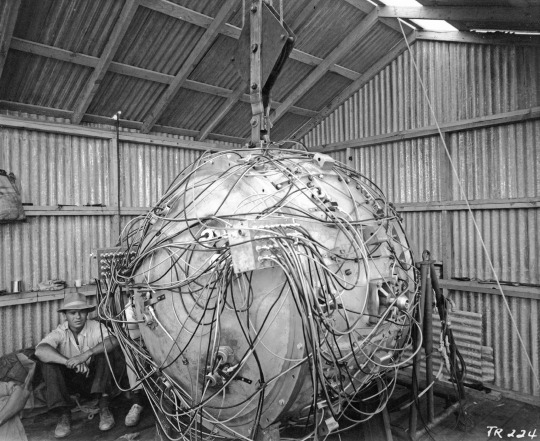
The Trinity bomb was the first atomic bomb ever tested. It was detonated in the Jornada del Muerto (Dead Man’s Walk) Desert, near Alamogordo, New Mexico, on July 16, 1945. The test was a resounding success. The United States would drop similar bombs on Japan just three weeks later. Credit: Courtesy of the Los Alamos National Laboratory Archives

Oppenheimer and General Leslie Groves inspect the melted remnants of the 100-foot steel tower that held the Trinity bomb. Ensuring that the testing of a bomb with unknown strength would remain completely secret, the government chose a location that was so remote they had to import their water from over 150 miles away. Credit: Copyright CORBIS

Oppenheimer and General Leslie Groves stand in front of a map of Japan, just five days before the bombing of Hiroshima. Credit: Copyright CORBIS

Though there was no evidence that Oppenheimer had betrayed his country in any way, several officials called his loyalty into question in the Cold War environment of 1954. After being subjected to months of hearings, “the most famous physicist in the world” eventually lost his government security clearance. Credit: Reprinted courtesy of TIME Magazine
#Atomic Secrets#Scientists#Atomic Bomb#American 🇺🇸 Experience#NOVA | PBS#Los Alamos National Laboratory#Manhattan Project#World War II#J. Robert Oppenheimer#Katherine Oppenheimer#New Mexico#Hiroshima | Nagasaki#University of California-Berkeley#Harvard University#Jornada del Muerto (Dead Man’s Walk) Desert 🐪#Alamogordo New Mexico#General Leslie Groves#Japan 🇯🇵#TIME Magazine
21 notes
·
View notes